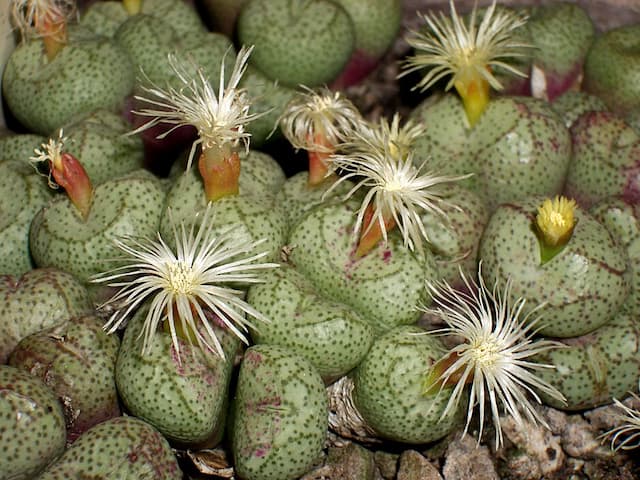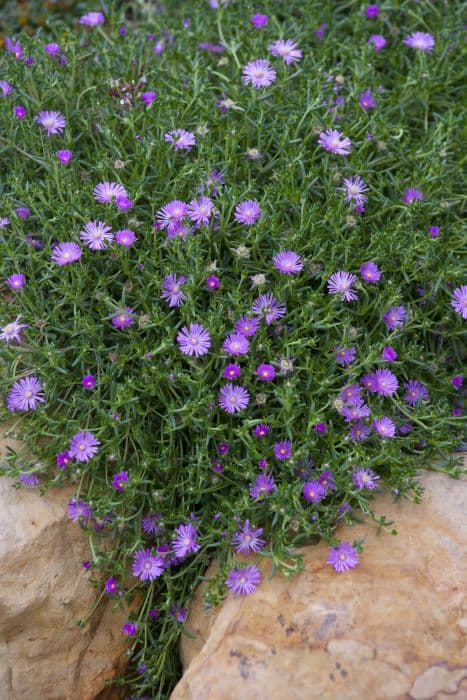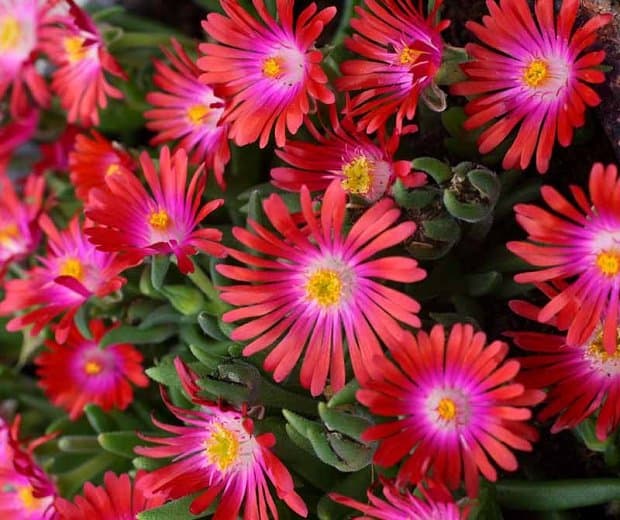Heartleaf Ice Plant Aptenia cordifolia

ABOUT
Aptenia cordifolia, commonly known as heartleaf ice plant or baby sun rose, has a distinctive fleshy, heart-shaped foliage which is bright green in color. This succulent ground cover bears small, daisy-like flowers that typically display a vibrant magenta or pinkish hue. The blossoms, appearing primarily in the warmer months, add a pop of color against the dense, mat-forming leaves. The stems of the heartleaf ice plant are often red-tinged, rambling across the ground and rooting at nodes. Its overall lush appearance, with its combination of glossy leaves and striking flowers, makes it a favored choice for rockeries, hanging baskets, and as a drought-tolerant landscaping element.
About this plant
 Names
NamesFamily
Aizoaceae.
Synonyms
Heartleaf Ice Plant, Baby Sun Rose, Red Apple, Dewplant.
Common names
Mesembryanthemum cordifolium, Aptenia lancifolia, Mesembryanthemum lancifolium, Mesembryanthemum cordifolium var. lancifolium.
 Toxicity
ToxicityTo humans
Heartleaf iceplant is generally considered non-toxic to humans. There are no well-documented cases of poisoning from ingesting this plant. However, like with any plant material, individual allergies or sensitivities could potentially cause mild stomach upset or an allergic reaction in some people.
To pets
Heartleaf iceplant is also generally considered non-toxic to pets. It is unlikely that ingestion of this plant will lead to any significant symptoms of poisoning in animals such as dogs or cats. As with humans, individual sensitivities could possibly result in mild gastrointestinal upset.
 Characteristics
CharacteristicsLife cycle
Perennials
Foliage type
Evergreen
Color of leaves
Green
Flower color
Magenta
Height
8 inches (20 cm)
Spread
24 inches (60 cm)
Plant type
Succulent
Hardiness zones
10
Native area
South Africa
Benefits
 General Benefits
General Benefits- Low Maintenance: Aptenia cordifolia, commonly known as the heartleaf iceplant, is a resilient and easy-to-care-for plant that requires minimal upkeep.
- Drought Tolerance: This plant has a high tolerance to drought conditions, making it an ideal choice for water-wise gardening and arid climates.
- Ground Cover: With its spreading habit, the heartleaf iceplant is an effective ground cover that can help reduce soil erosion and suppress weeds.
- Decorative Appearance: It features bright green, heart-shaped leaves and vibrant, daisy-like flowers, adding aesthetic appeal to gardens and landscapes.
- Soil Adaptability: Aptenia cordifolia can thrive in a variety of soil types, although it prefers well-draining soils.
- Fast Growth: The plant grows quickly, which can be beneficial for covering bare spots in the garden in a short period.
- Heat Tolerance: It can withstand high temperatures, making it suitable for hot and sunny locations where other plants may struggle.
- Wildlife Attraction: The flowers can attract pollinators such as bees and butterflies, which are beneficial for the garden ecosystem.
- Edible Qualities: Some parts of the plant are edible and can be used in salads or as garnishes, though this should be done with caution and proper knowledge.
 Medical Properties
Medical Properties- Anti-inflammatory: Heartleaf Ice Plant is traditionally used to reduce inflammation.
- Antiseptic: It is known to possess antiseptic properties that can aid in preventing infection in wounds.
- Analgesic: Some sources claim that it may have pain-relieving capabilities.
 Air-purifying Qualities
Air-purifying QualitiesThis plant is not specifically known for air purifying qualities.
 Other Uses
Other Uses- Aptenia cordifolia, commonly known as Heartleaf Ice Plant, can be used as a living mulch in gardens, covering the soil to protect it from erosion and reduce the need for watering.
- The succulent leaves of the Heartleaf Ice Plant can be utilized as a moisture indicator; they plump when water is plentiful and shrivel when the soil is dry, signaling the need for irrigation.
- Heartleaf Ice Plant can serve as a green roof plant, its ability to withstand drought making it suitable for creating a low-maintenance and visually appealing rooftop garden.
- Due to its mat-forming growth, Heartleaf Ice Plant can be used for stabilizing slopes and banks, preventing soil erosion and giving landscape architects a functional aesthetic tool.
- In culinary applications, the Heartleaf Ice Plant's edible leaves can be added to salads for a crunchy texture or used as a garnish due to their unique appearance.
- In crafts, the vibrant and fleshy leaves of the Heartleaf Ice Plant can be incorporated into floral arrangements or used to create natural jewelry, like brooches or necklaces.
- Heartleaf Ice Plant can act as a natural dye source, where its pigments may be extracted to tint fabrics or art supplies with shades of green.
- As an educational tool, Heartleaf Ice Plant can be included in school projects to teach children about succulent plants and their adaptations to arid environments.
- Its drought-tolerant nature makes Heartleaf Ice Plant ideal for xeriscaping, helping gardeners create landscapes that require minimal water resources.
- In thermal insulation applications, the dense and fleshy foliage of the Heartleaf Ice Plant can contribute to insulating properties if planted strategically around buildings.
Interesting Facts
 Feng Shui
Feng ShuiThe Heartleaf Iceplant is not used in Feng Shui practice.
 Zodiac Sign Compitability
Zodiac Sign CompitabilityThe Heartleaf Iceplant is not used in astrology practice.
 Plant Symbolism
Plant Symbolism- Love and Affection: Aptenia cordifolia, commonly known as the "heartleaf iceplant" due to its heart-shaped leaves, often symbolizes love and affection, reflecting the shape's natural association with the heart.
- Perseverance and Resilience: As a succulent that thrives in harsh conditions, the heartleaf iceplant represents the ability to persevere and remain resilient even in challenging environments.
- Everlasting Bonds: This plant can quickly form a dense mat of foliage, which symbolizes strong and everlasting bonds in relationships, much like the interconnectedness of its growth pattern.
 Water
WaterBaby sun rose needs moderate watering, typically once a week, making sure the soil is allowed to dry slightly between waterings. In hotter, drier climates, the plant may require more frequent watering, such as twice a week. Water thoroughly until excess water drains out of the pot, but avoid letting the plants sit in standing water. An estimated amount could be around 16 ounces per week for a small pot, adjusting as needed for larger pots or warmer, windier weather. Over-watering or poor drainage can lead to root rot, so it's essential to ensure good soil drainage.
 Light
LightThe baby sun rose thrives in full sun to partial shade, preferring a location where it can receive at least four to six hours of sunlight daily. An ideal spot would be an east- or south-facing window, or a balcony or outdoor spot that receives generous morning or afternoon sun. Insufficient light may cause the plant to become leggy and lose the vibrancy of its foliage and flowers.
 Temperature
TemperatureBaby sun rose prefers warm temperatures, ideally between 60°F and 75°F. It can tolerate minimum temperatures down to about 30°F, though frost can damage the plant. To ensure robust growth, avoid exposing the baby sun rose to conditions outside of its ideal temperature range; its growth will be very minimal in cooler temperatures.
 Pruning
PruningPruning the baby sun rose helps maintain its shape, encourage bushier growth, and remove dead or damaged foliage. Pruning is best done in the spring before the new growth starts or after flowering to encourage a second bloom. Cut back up to one-third of the plant to keep it compact and healthy. Regular trimming, about every few months, can also prevent the plant from becoming too leggy.
 Cleaning
CleaningAs needed
 Soil
SoilBaby Sun Rose thrives in well-draining soil with a sandy or gritty composition, often a cactus or succulent mix, ensuring proper drainage. A soil pH range of 6.0 to 7.5 is optimal for its growth. An ideal soil mix might include one part potting soil, one part perlite or sand, and one part compost to nourish the plant.
 Repotting
RepottingBaby Sun Rose should be repotted every two to three years to replenish nutrients and accommodate root growth. Choose a pot only slightly larger than the current one to prevent water retention, which could lead to root rot.
 Humidity & Misting
Humidity & MistingBaby Sun Rose prefers a dry environment and is tolerant of low humidity levels. It's best to avoid high humidity conditions to prevent potential fungal issues and replicate its native arid habitat conditions.
 Suitable locations
Suitable locationsIndoor
Place Baby Sun Rose in a sunny spot; water sparingly.
Outdoor
Full sun exposure; well-draining soil; water moderately.
Hardiness zone
9-11 USDA
 Life cycle
Life cycleAptenia cordifolia, commonly known as Heartleaf Ice Plant, begins its life as a seed, which when sown in warm, well-drained soil, germinates within weeks. The seedlings rapidly develop into a sprawling mat of succulent, heart-shaped leaves with stems that root at the nodes, contributing to vegetative growth and propagation. Throughout the warmer months, the plant blooms with small, bright magenta or pink daisy-like flowers that open in full sunlight and are pollinated by insects, leading to the production of fruit. The fruits mature and eventually dry, releasing seeds to start the cycle anew. Under optimal conditions, this perennial continues to grow and can spread extensively to cover ground, forming dense mats. Over time, without proper care, older parts may die back, but new growth will usually emerge from the healthy sections of the plant.
 Propogation
PropogationPropogation time
Spring-Summer
Propogation: Heartleaf ice plant (Aptenia cordifolia) is commonly propagated during the warmer months of the year, spring and summer, when the plant is actively growing. The most popular method of propagation for this plant is through stem cuttings. To propagate, a healthy stem is selected and snipped, ideally about 4-6 inches (10-15 centimeters) in length. The cut end is then allowed to callous over for a day or two to prevent rotting. Once calloused, the cutting is planted in a well-draining soil mix and watered lightly. Roots usually form within a few weeks, after which the plants can be gradually acclimated to normal watering routines. This simple and effective method yields new plants that are true to the parent, ensuring the propagation of its favorable characteristics.








![Ice plant [Fire Spinner]](/_next/image?url=https%3A%2F%2Fplants-admin.emdemapps.com%2Fimages%2Fplants%2F%2Fimages%2F604b54d98722a.png&w=640&q=75)
